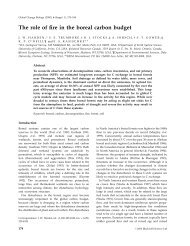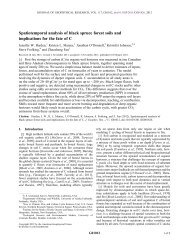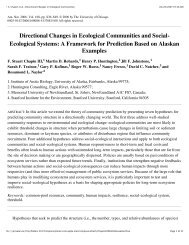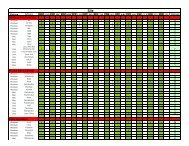Verbyla, D.. 2008 The greening and browning of Alaska based on ...
Verbyla, D.. 2008 The greening and browning of Alaska based on ...
Verbyla, D.. 2008 The greening and browning of Alaska based on ...
You also want an ePaper? Increase the reach of your titles
YUMPU automatically turns print PDFs into web optimized ePapers that Google loves.
<str<strong>on</strong>g>Alaska</str<strong>on</strong>g> NDVI trends<br />
woolly sawfly/stem cankers in alders (Ruess et al., 2006). <str<strong>on</strong>g>The</str<strong>on</strong>g> area<br />
affected by insect <str<strong>on</strong>g>and</str<strong>on</strong>g> disease infestati<strong>on</strong>s exceeds wildfire in<br />
boreal <str<strong>on</strong>g>Alaska</str<strong>on</strong>g> (Malmstrom & Raffa, 2000) <str<strong>on</strong>g>and</str<strong>on</strong>g> would probably<br />
cause a decrease in NDVI.<br />
<str<strong>on</strong>g>The</str<strong>on</strong>g> lack <str<strong>on</strong>g>of</str<strong>on</strong>g> simple correlati<strong>on</strong>s between interannual maximum<br />
NDVI <str<strong>on</strong>g>and</str<strong>on</strong>g> precipitati<strong>on</strong> am<strong>on</strong>g boreal climate stati<strong>on</strong> buffers is<br />
not surprising. Spatial variati<strong>on</strong> <str<strong>on</strong>g>of</str<strong>on</strong>g> precipitati<strong>on</strong> is high relative<br />
to temperature (Simps<strong>on</strong> et al., 2002). For example, the Fairbanks<br />
<str<strong>on</strong>g>and</str<strong>on</strong>g> Delta climate stati<strong>on</strong>s both occur <strong>on</strong> the Tanana River<br />
floodplain with overlapping 100-km climate buffers (Fig. 2),<br />
have str<strong>on</strong>gly correlated annual maximum NDVI values (Pears<strong>on</strong>’s<br />
r = 0.91, 1982–2003), <str<strong>on</strong>g>and</str<strong>on</strong>g> mean m<strong>on</strong>thly temperature (Pears<strong>on</strong>’s<br />
r = 0.99, 1982–2003). However, the correlati<strong>on</strong> <str<strong>on</strong>g>of</str<strong>on</strong>g> m<strong>on</strong>thly total<br />
precipitati<strong>on</strong> between these two stati<strong>on</strong>s is substantially lower<br />
(Pears<strong>on</strong>’s r = 0.61, 1982–2003), <str<strong>on</strong>g>and</str<strong>on</strong>g> the actual mean precipitati<strong>on</strong><br />
within 100 km <str<strong>on</strong>g>of</str<strong>on</strong>g> each climate buffer is likely to vary<br />
substantially relative to precipitati<strong>on</strong> at a climate stati<strong>on</strong>.<br />
<str<strong>on</strong>g>The</str<strong>on</strong>g> short-term resp<strong>on</strong>se <str<strong>on</strong>g>of</str<strong>on</strong>g> boreal trees to precipitati<strong>on</strong> may<br />
also be species- <str<strong>on</strong>g>and</str<strong>on</strong>g> site-specific. For example, Yarie & Van Cleve<br />
(2006) found reduced diameter growth <str<strong>on</strong>g>of</str<strong>on</strong>g> floodplain white<br />
spruce <str<strong>on</strong>g>and</str<strong>on</strong>g> balsam poplar trees, but not in most upl<str<strong>on</strong>g>and</str<strong>on</strong>g> species<br />
in a rain-exclusi<strong>on</strong> experiment. Barr et al. (2004) found a decline<br />
in aspen maximum leaf area index during a 4-year drought, but<br />
no c<strong>on</strong>comitant decline from understorey hazelnut canopies.<br />
<str<strong>on</strong>g>The</str<strong>on</strong>g> l<strong>on</strong>g-term decreasing trend in NDVI in boreal <str<strong>on</strong>g>Alaska</str<strong>on</strong>g> is in<br />
c<strong>on</strong>trast to an increasing trend in the boreal forest <str<strong>on</strong>g>of</str<strong>on</strong>g> the<br />
Komi Republic <str<strong>on</strong>g>of</str<strong>on</strong>g> north-west Russia (Lopatin et al., 2006). Both<br />
regi<strong>on</strong>s have experienced warming since the early 1980s.<br />
However, much <str<strong>on</strong>g>of</str<strong>on</strong>g> boreal <str<strong>on</strong>g>Alaska</str<strong>on</strong>g> is semi-arid with potential<br />
evapotranspirati<strong>on</strong> exceeding precipitati<strong>on</strong> (Barber et al., 2000;<br />
Gower et al., 2001), while precipitati<strong>on</strong> exceeds potential<br />
evapotranspirati<strong>on</strong> in the Komi Republic (Lopatin et al., 2006).<br />
In this study, the NDVI regressi<strong>on</strong> slopes were most negative <str<strong>on</strong>g>and</str<strong>on</strong>g><br />
the R 2 values were greatest from the warmest <str<strong>on</strong>g>and</str<strong>on</strong>g> driest boreal<br />
ecoz<strong>on</strong>es (Table 2). <str<strong>on</strong>g>The</str<strong>on</strong>g> str<strong>on</strong>gest negative trends am<strong>on</strong>g boreal<br />
climate stati<strong>on</strong> buffers were also from relatively warm/dry areas<br />
with an annual precipitati<strong>on</strong> <str<strong>on</strong>g>of</str<strong>on</strong>g> less than 500 mm <str<strong>on</strong>g>and</str<strong>on</strong>g> mean<br />
summer temperature above 12 °C (Table 3).<br />
Although the GIMMS-NDVI data have been corrected for<br />
major volcanic erupti<strong>on</strong>s, sensor calibrati<strong>on</strong> <str<strong>on</strong>g>and</str<strong>on</strong>g> orbital drift<br />
over time, c<strong>on</strong>founding factors leading to residual error are<br />
possible, including reducti<strong>on</strong> <str<strong>on</strong>g>of</str<strong>on</strong>g> NDVI due to cloud <str<strong>on</strong>g>and</str<strong>on</strong>g> cloud<br />
shadow, extreme viewing angles, low solar elevati<strong>on</strong> early or late<br />
in the growing seas<strong>on</strong> <str<strong>on</strong>g>and</str<strong>on</strong>g> atmospheric effects. <str<strong>on</strong>g>The</str<strong>on</strong>g> strategy <str<strong>on</strong>g>of</str<strong>on</strong>g><br />
selecting the maximum NDVI during a composite period lessens<br />
the effect <str<strong>on</strong>g>of</str<strong>on</strong>g> these c<strong>on</strong>founding factors, but does not completely<br />
eliminate these problems. However, the NDVI trends in this<br />
study c<strong>on</strong>sistently occurred at a variety <str<strong>on</strong>g>of</str<strong>on</strong>g> spatial scales. For<br />
example, cold artic tundra had significant increasing trends in<br />
annual maximum NDVI at the ecoregi<strong>on</strong> <str<strong>on</strong>g>and</str<strong>on</strong>g> 100-km buffer<br />
scale, while warmer shrub tundra from western <str<strong>on</strong>g>Alaska</str<strong>on</strong>g> had no<br />
significant trends at these spatial scales. Boreal forest had significant<br />
decreasing trends at all spatial scales examined <str<strong>on</strong>g>and</str<strong>on</strong>g> the<br />
trends were c<strong>on</strong>sistently str<strong>on</strong>gest in the eastern interior where<br />
growing seas<strong>on</strong>s are the warmest <str<strong>on</strong>g>and</str<strong>on</strong>g> driest relative to other areas<br />
in this study.<br />
ACKNOWLEDGEMENTS<br />
I thank Scott Goetz, Martha Raynolds, John Yarie <str<strong>on</strong>g>and</str<strong>on</strong>g> the<br />
an<strong>on</strong>ymous referees for their useful suggesti<strong>on</strong>s that helped<br />
improved the manuscript. This research was supported by the<br />
B<strong>on</strong>anza Creek LTER (L<strong>on</strong>g-Term Ecological Research) program<br />
(funded jointly by NSF grant DEB-0423442 <str<strong>on</strong>g>and</str<strong>on</strong>g> USDA Forest<br />
Service, Pacific Northwest Research Stati<strong>on</strong> grant PNW01-<br />
JV11261952-231).<br />
REFERENCES<br />
Angert, A., Biraud, S., B<strong>on</strong>fils, C., Henning, C.C., Buermann, W.,<br />
Pinz<strong>on</strong>, J., Tucker, C.J. & Fung, I. (2005) Drier summers cancel<br />
out the CO 2 uptake enhancement induced by warmer springs.<br />
Proceedings <str<strong>on</strong>g>of</str<strong>on</strong>g> the Nati<strong>on</strong>al Academy <str<strong>on</strong>g>of</str<strong>on</strong>g> Sciences USA, 102,<br />
10823–10827.<br />
Barber, V.G., Juday, G.P. & Finney, B.P. (2000) Reduced growth<br />
<str<strong>on</strong>g>of</str<strong>on</strong>g> <str<strong>on</strong>g>Alaska</str<strong>on</strong>g>n white spruce in the twentieth century from<br />
temperature-induced drought stress. Nature, 405, 668–<br />
673.<br />
Barber, V.G., Juday, G.P., Finney, B.P. & Wilmking, M. (2004)<br />
Rec<strong>on</strong>structi<strong>on</strong> <str<strong>on</strong>g>of</str<strong>on</strong>g> summer temperatures in interior <str<strong>on</strong>g>Alaska</str<strong>on</strong>g><br />
from tree-ring proxies: Evidence for changing climate regimes.<br />
Climatic Change, 63, 91–120.<br />
Barr, A.G., Black, T.A., Hogg, E.H., Kljun, N., Morgenstern, K. &<br />
Nesic, Z. (2004) Inter-annual variability in the leaf area index<br />
<str<strong>on</strong>g>of</str<strong>on</strong>g> a boreal aspen-hazelnut forest in relati<strong>on</strong> to net ecosystem<br />
producti<strong>on</strong>. Agricultural <str<strong>on</strong>g>and</str<strong>on</strong>g> Forest Meteorology, 126, 237–255.<br />
Berg, E., Henry, J.D., Fastie, C.L., De Volder, A.D. & Matsuoka, S.M.<br />
(2006) Spruce beetle outbreaks <strong>on</strong> the Kenai Peninsula, <str<strong>on</strong>g>Alaska</str<strong>on</strong>g><br />
<str<strong>on</strong>g>and</str<strong>on</strong>g> Kluane Nati<strong>on</strong>al Park <str<strong>on</strong>g>and</str<strong>on</strong>g> Reserve, Yuk<strong>on</strong> Territory:<br />
relati<strong>on</strong>ship to summer temperatures <str<strong>on</strong>g>and</str<strong>on</strong>g> regi<strong>on</strong>al differences<br />
in disturbance regimes. Forest Ecology <str<strong>on</strong>g>and</str<strong>on</strong>g> Management, 227,<br />
219–232.<br />
Bunn, A.G. & Goetz, S.J. (2006) Trends in satellite-observed<br />
circumpolar photosynthetic activity from 1982 to 2003: the<br />
influence <str<strong>on</strong>g>of</str<strong>on</strong>g> seas<strong>on</strong>ality, cover type <str<strong>on</strong>g>and</str<strong>on</strong>g> vegetati<strong>on</strong> density.<br />
Earth Interacti<strong>on</strong>s, 10, 1–19.<br />
Bunn, A.G., Goetz, S.J. & Fiske, G.J. (2005) Observed <str<strong>on</strong>g>and</str<strong>on</strong>g><br />
predicted resp<strong>on</strong>ses <str<strong>on</strong>g>of</str<strong>on</strong>g> plant growth to climate across Canada.<br />
Geophysical Research Letters, 32, L16710, doi:10.1029/<br />
2005GL023646.<br />
Bunn, A.G., Goetz, S.J., Kimball, J.S. & Zhang, K. (2007) Northern<br />
high-latitude ecosystems resp<strong>on</strong>d to climate change. EOS,<br />
Transacti<strong>on</strong>s <str<strong>on</strong>g>of</str<strong>on</strong>g> the American Geophysical Uni<strong>on</strong>, 88, 333–340.<br />
Chapin, F.S. III, Sturm, M., Serreze, M.C., McFadden, J.P.,<br />
Key, J.R., Lloyd, A.H., McGuire, A.D., Rupp, T.S., Lynch, A.H.,<br />
Schimel, J.P., Beringer, J., Chapman, W.L., Epstein, H.E.,<br />
Euskirchen, E.S., Hinzman, L.D., Jia., G., Ping, C.L., Tape, K.D.,<br />
Thomps<strong>on</strong>, C.D., Walker, D.A. & Welker., J.M. (2005) Role <str<strong>on</strong>g>of</str<strong>on</strong>g><br />
l<str<strong>on</strong>g>and</str<strong>on</strong>g>-surface changes in arctic summer warming. Science, 310,<br />
657–660.<br />
Doak, P., Wagner, D. & Wats<strong>on</strong>, A. (2007) Variable extrafloral<br />
nectary expressi<strong>on</strong> <str<strong>on</strong>g>and</str<strong>on</strong>g> its c<strong>on</strong>sequences in quaking aspen.<br />
Canadian Journal <str<strong>on</strong>g>of</str<strong>on</strong>g> Botany, 85, 1–9.<br />
© <str<strong>on</strong>g>2008</str<strong>on</strong>g> <str<strong>on</strong>g>The</str<strong>on</strong>g> Author<br />
Global Ecology <str<strong>on</strong>g>and</str<strong>on</strong>g> Biogeography, 17, 547–555, Journal compilati<strong>on</strong> © <str<strong>on</strong>g>2008</str<strong>on</strong>g> Blackwell Publishing Ltd 553







